初一英语重点句型[1]
- 格式:doc
- 大小:56.00 KB
- 文档页数:8
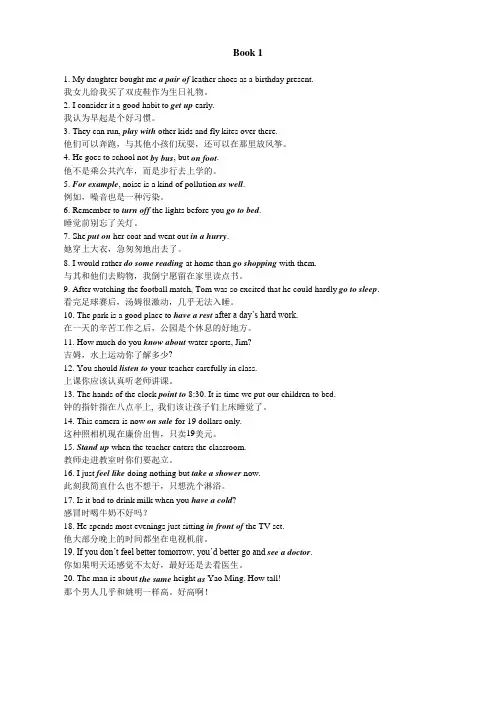
Book 11. My daughter bought me a pair of leather shoes as a birthday present.我女儿给我买了双皮鞋作为生日礼物。
2. I consider it a good habit to get up early.我认为早起是个好习惯。
3. They can run, play with other kids and fly kites over there.他们可以奔跑,与其他小孩们玩耍,还可以在那里放风筝。
4. He goes to school not by bus, but on foot.他不是乘公共汽车,而是步行去上学的。
5. For example, noise is a kind of pollution as well.例如,噪音也是一种污染。
6. Remember to turn off the lights before you go to bed.睡觉前别忘了关灯。
7. She put on her coat and went out in a hurry.她穿上大衣,急匆匆地出去了。
8. I would rather do some reading at home than go shopping with them.与其和他们去购物,我倒宁愿留在家里读点书。
9. After watching the football match, Tom was so excited that he could hardly go to sleep. 看完足球赛后,汤姆很激动,几乎无法入睡。
10. The park is a good place to have a rest a fter a day’s hard work.在一天的辛苦工作之后,公园是个休息的好地方。
11. How much do you know about water sports, Jim?吉姆,水上运动你了解多少?12. You should listen to your teacher carefully in class.上课你应该认真听老师讲课。
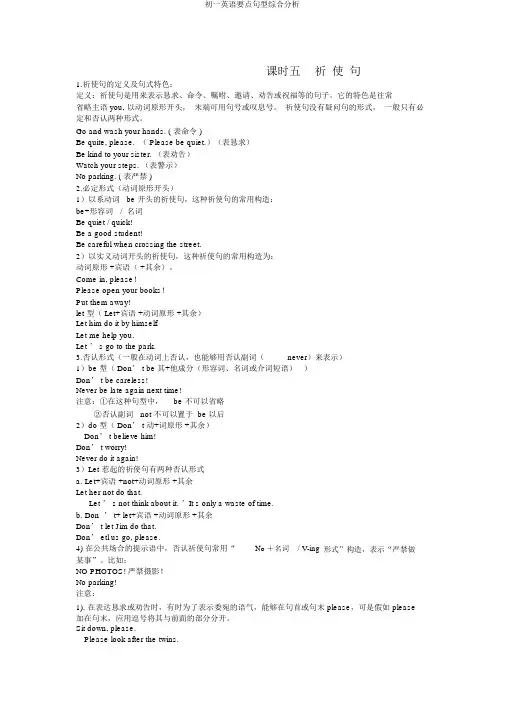
课时五祈使句1.祈使句的定义及句式特色:定义:祈使句是用来表示恳求、命令、嘱咐、邀请、劝告或祝福等的句子。
它的特色是往常省略主语 you, 以动词原形开头,末端可用句号或叹息号。
祈使句没有疑问句的形式,一般只有必定和否认两种形式。
Go and wash your hands. ( 表命令 )Be quite, please. ( Please be quiet.)(表恳求)Be kind to your sister. (表劝告)Watch your steps. (表警示)No parking. ( 表严禁 )2.必定形式(动词原形开头)1)以系动词be 开头的祈使句,这种祈使句的常用构造:be+形容词/ 名词Be quiet / quick!Be a good student!Be careful when crossing the street.2)以实义动词开头的祈使句,这种祈使句的常用构造为:动词原形 +宾语( +其余)。
Come in, please!Please open your books!Put them away!let 型( Let+宾语 +动词原形 +其余)Let him do it by himself.Let me help you.Let ’ s go to the park.3.否认形式(一般在动词上否认,也能够用否认副词(never)来表示)1)be 型( Don’ t be 其+他成分(形容词、名词或介词短语))Don’ t be careless!Never be late again next time!注意:①在这种句型中,be 不可以省略②否认副词not 不可以置于 be 以后2)do 型( Don’ t 动+词原形 +其余)Don’ t believe him!Don’ t worry!Never do it again!3)Let 惹起的祈使句有两种否认形式a. Let+宾语 +not+动词原形 +其余Let her not do that.Let ’ s not think about it. ’It s only a waste of time.b. Don ’ t+ let+宾语 +动词原形 +其余Don’ t let Jim do that.Don’ etl us go, please.4) 在公共场合的提示语中,否认祈使句常用“No +名词/ V-ing形式”构造,表示“严禁做某事”。
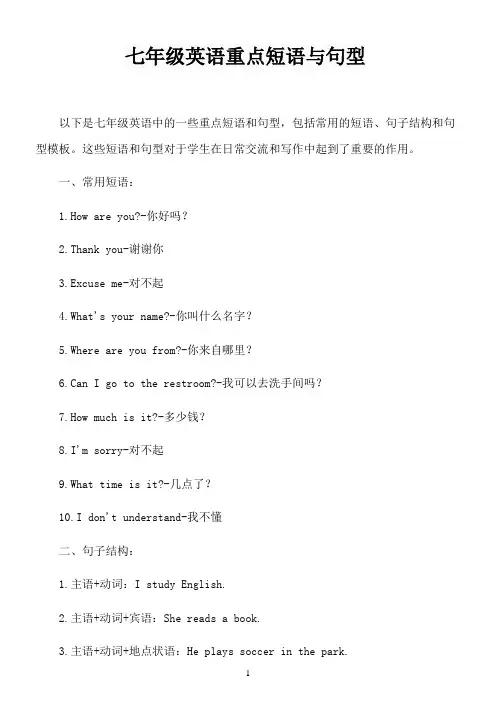
七年级英语重点短语与句型以下是七年级英语中的一些重点短语和句型,包括常用的短语、句子结构和句型模板。
这些短语和句型对于学生在日常交流和写作中起到了重要的作用。
一、常用短语:1.How are you?-你好吗?2.Thank you-谢谢你3.Excuse me-对不起4.What's your name?-你叫什么名字?5.Where are you from?-你来自哪里?6.Can I go to the restroom?-我可以去洗手间吗?7.How much is it?-多少钱?8.I'm sorry-对不起9.What time is it?-几点了?10.I don't understand-我不懂二、句子结构:1.主语+动词:I study English.2.主语+动词+宾语:She reads a book.3.主语+动词+地点状语:He plays soccer in the park.4.主语+动词+时间状语:We have class at 8 o'clock.5.主语+动词+宾语+地点状语:They eat dinner at home.三、句型模板:1.What+be+主语+like?-询问某人的外貌或性格特征。
Example:What is your sister like?-你妹妹长什么样?2.Can+主语+动词原形?-提出请求或询问能力。
Example:Can you help me?-你能帮我吗?3.How+be+主语?-询问某人的状态或感觉。
Example:How are you?-你好吗?4.What+do+主语+like?-询问某人的爱好或喜欢的事物。
Example:What does she like to do?-她喜欢做什么?5.Why+do/does+主语+动词原形?-询问原因或理由。
Example:Why do they go to the park?-他们为什么去公园?通过以上的短语和句型,学生可以在日常交流和写作中灵活运用。
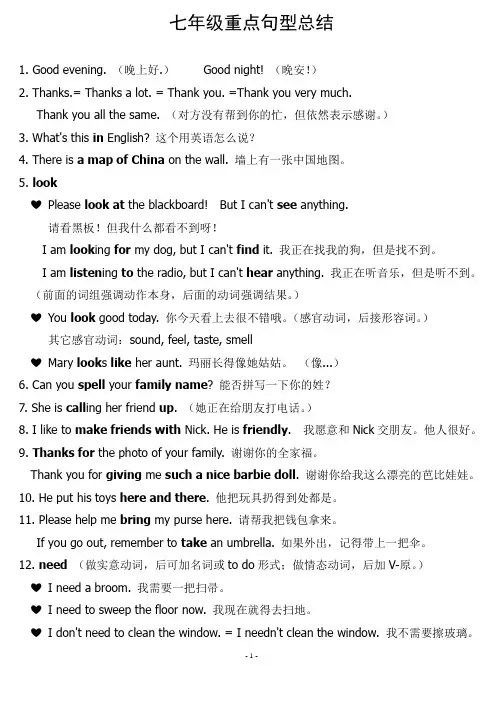
七年级重点句型总结1. Good evening. (晚上好.)Good night! (晚安!)2. Thanks.= Thanks a lot. = Thank you. =Thank you very much.Thank you all the same. (对方没有帮到你的忙,但依然表示感谢。
)3. What's this in English? 这个用英语怎么说?4. There is a map of China on the wall. 墙上有一张中国地图。
5. look❤Please look at the blackboard! But I can't see anything.请看黑板!但我什么都看不到呀!I am look ing for my dog, but I can't find it. 我正在找我的狗,但是找不到。
I am listen ing to the radio, but I can't hear anything. 我正在听音乐,但是听不到。
(前面的词组强调动作本身,后面的动词强调结果。
)❤You look good today. 你今天看上去很不错哦。
(感官动词,后接形容词。
)其它感官动词:sound, feel, taste, smell❤Mary look s like her aunt. 玛丽长得像她姑姑。
(像...)6. Can you spell your family name? 能否拼写一下你的姓?7. She is call ing her friend up. (她正在给朋友打电话。
)8. I like to make friends with Nick. He is friendly. 我愿意和Nick交朋友。
他人很好。
9. Thanks for the photo of your family. 谢谢你的全家福。

准初一生预习:七年级上册英语unit1重点单词短语及语法句型以下内容是来自广州(深圳上海)牛津版的英语教材整理而成,供大家暑假预习用!今天先学7A UNIT 1 Making friends的内容!家长可以帮孩子收藏!Ⅰ重点单词:World n. 世界 country n. 国家 Japan n.日本Germany n. 德国 German adj.德国的 n.德国人grammar n.语法 blog n. 博客 sound n. 声音Everyone n.人人(谓语动词要用单数)Hobby n.爱好(复数hobbies) age n. 年龄elder adj. 年长的 dream n. 梦想 complete v. 完成Us pron.我们 yourself pron.你自己 friendly adj. 友爱的engineer n. 工程师 flat n.公寓 mountain n. 山Ⅱ重点短语:1.colse to 接近 = near 反义词:far (away)from 远离2.Go to school 去上学3.Be good at 擅长 =do well in 反义词:be bad /poor at=do badly in不擅长4.Make friends with 与……交朋友 make friends 交朋友5.All over 遍及6.I’d like to=would like to 愿意Ⅲ重点句型:1.what does···mean?2.welcome to3.I like···because···4.My dream is to be··?5.How old is/are ····?6.What does ····do?详细讲解:1.Read a German girl’s blog。
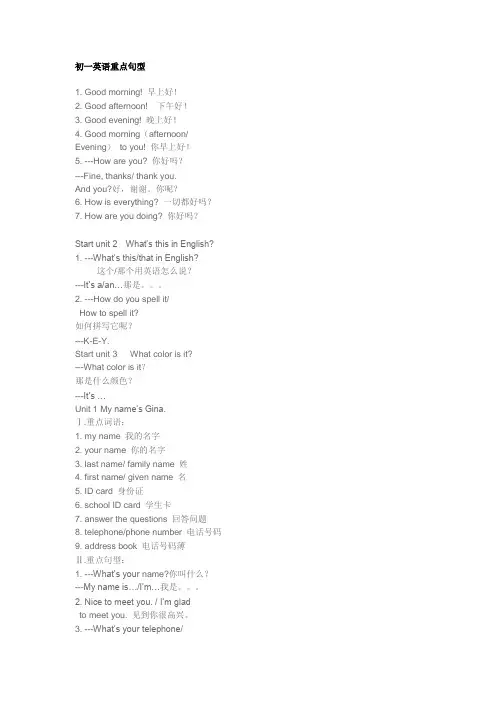
初一英语重点句型1. Good morning! 早上好!2. Good afternoon! 下午好!3. Good evening! 晚上好!4. Good morning(afternoon/ Evening)to you! 你早上好!5. ---How are you? 你好吗?---Fine, thanks/ thank you.And you?好,谢谢。
你呢?6. How is everything? 一切都好吗?7. How are you doing? 你好吗?Start unit 2 What’s this in English?1. ---What’s this/that in English?这个/那个用英语怎么说?---It’s a/an…那是。
2. ---How do you spell it/How to spell it?如何拼写它呢?---K-E-Y.Start unit 3 What color is it?---What color is it?那是什么颜色?---It’s …Unit 1 My name’s Gina.Ⅰ.重点词语:1. my name 我的名字2. your name 你的名字3. last name/ family name 姓4. first name/ given name 名5. ID card 身份证6. school ID card 学生卡7. answer the questions 回答问题8. telephone/phone number 电话号码9. address book 电话号码薄Ⅱ.重点句型:1. ---What’s your name?你叫什么?---My name is…/I’m…我是。
2. Nice to meet you. / I’m gladto meet you. 见到你很高兴。
3. ---What’s your telephone/phone number? 你的电话是多少?---My telephone/ phone number is…我的电话是。

七年级英语知识点重点句型在七年级的英语学习中,重点句型是必不可少的知识点。
本文将介绍七年级英语知识点重点句型,帮助学生掌握这些句型,提高英语语言表达能力。
一、祈使句祈使句是用来表示命令、请求、劝告、建议等行为的一种句子类型。
通常情况下,祈使句的主语是省略的。
一些常见的祈使句包括:1. Turn off the light.(关灯。
)2. Come here.(来这里。
)3. Please be quiet.(请保持安静。
)4. Don't be late.(别迟到。
)二、一般疑问句一般疑问句是用来询问事实真假、肯定与否定的一种句子类型。
一般疑问句的基本结构是将be动词、助动词等提到主语前面形成的陈述句语序。
一些常见的一般疑问句包括:1. Are you a student?(你是学生吗?)2. Do you like pizza?(你喜欢披萨吗?)3. Can you swim?(你会游泳吗?)4. Is he your brother?(他是你的兄弟吗?)三、特殊疑问句特殊疑问句是用来询问一些特定信息的一种句子类型。
特殊疑问句通常以疑问词开头,疑问词包括who、what、where、when、why、how等。
一些常见的特殊疑问句包括:1. What did you have for breakfast?(你早餐吃了什么?)2. Where is the library?(图书馆在哪里?)3. How old are you?(你多大了?)4. Why are you crying?(你为什么在哭?)四、there be句型there be句型是用来表示某地有某物或某人的一种句子类型。
在句型中,there引导引导语态,be动词后面跟着一个介词短语,介词短语表示与存在有关的地点、时间等。
一些常见的there be句型包括:1. There is a book on the desk.(桌子上有一本书。
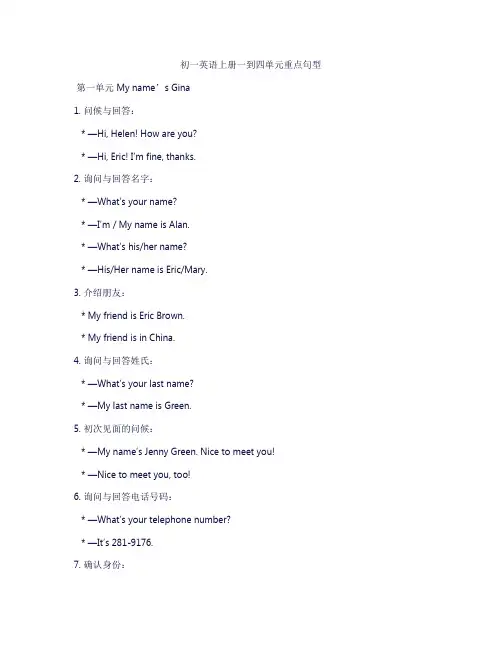
初一英语上册一到四单元重点句型 第一单元 My name’s Gina 1. 问候与回答: * —Hi, Helen! How are you? * —Hi, Eric! I’m fine, thanks. 2. 询问与回答名字: * —What’s your name? * —I’m / My name is Alan. * —What’s his/her name? * —His/Her name is Eric/Mary. 3. 介绍朋友: * My friend is Eric Brown. * My friend is in China. 4. 询问与回答姓氏: * —What’s your last name? * —My last name is Green. 5. 初次见面的问候: * —My name’s Jenny Green. Nice to meet you! * —Nice to meet you, too! 6. 询问与回答电话号码: * —What’s your telephone number? * —It’s 281-9176. 7. 确认身份: * —Are you Helen? * —Yes, I am. * —Is he Jack? * —Yes, he is. / No, he isn’t. 第二单元 This is my sister 1. 介绍家庭成员: * This is my friend Jane. * These are my brothers. * Those are my brothers. * That’s my family. 2. 询问与回答家庭成员身份: * —Are those/these your parents? * —Yes, they are. * —Who’s he? * —He’s my brother, Paul. * —Who are they? * —They’re my grandparents. 3. 描述家庭成员照片: * Here are two nice photos of my family. * My grandfather and grandmother are in the first photo. * In the next picture are my brothers, Bob and Eric. 第三单元 Is this your pencil? 1. 询问与回答物品: * —What’s this? * —It’s a watch. * —How do you spell it? * —W-A-T-C-H. 2. 确认物品归属: * —Is this/that your pencil? * —Yes, it is. It’s mine. / No, it isn’t. It’s his. 3. 礼貌询问与回答: * —Excuse me, is this your pencil? * —Yes, thank you. 4. 询问与回答物品复数: * —Are these your books? * —Yes, they are. They are mine. * —Are those your keys? * —No, they aren’t. They’re Bob’s. 5. 感谢与回应: * Thank you for your help. * You’re welcome. 第四单元 Where’s my schoolbag? 1. 询问物品位置: * —Where’s the schoolbag? * —It’s under the table. * —Where are my books? * —They’re on the sofa. * —Where is your ruler? * —It’s in the drawer. 2. 确认物品位置: * —Where’s my bag? * —Is it on your desk? * —Yes, it is. / No, it isn’t. 3. 否定物品位置: * It’s not under the chair. 4. 推测物品位置: * I think it’s in your grandparents’ room. 5. 描述个人习惯: * I’m tidy, but Gina is not. 6. 描述物品存在: * I have a clock. * Gina’s books are everywhere.
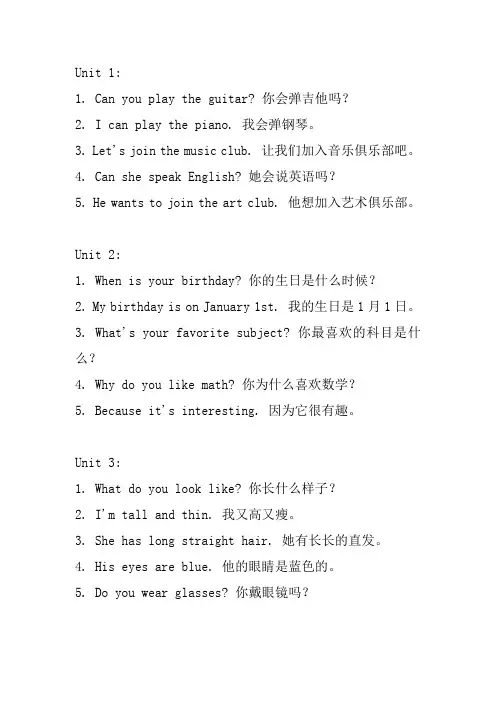
1. Can you play the guitar? 你会弹吉他吗?2. I can play the piano. 我会弹钢琴。
3. Let's join the music club. 让我们加入音乐俱乐部吧。
4. Can she speak English? 她会说英语吗?5. He wants to join the art club. 他想加入艺术俱乐部。
Unit 2:1. When is your birthday? 你的生日是什么时候?2. My birthday is on January 1st. 我的生日是1月1日。
3. What's your favorite subject? 你最喜欢的科目是什么?4. Why do you like math? 你为什么喜欢数学?5. Because it's interesting. 因为它很有趣。
Unit 3:1. What do you look like? 你长什么样子?2. I'm tall and thin. 我又高又瘦。
3. She has long straight hair. 她有长长的直发。
4. His eyes are blue. 他的眼睛是蓝色的。
5. Do you wear glasses? 你戴眼镜吗?1. How do you get to school? 你怎么去学校?2. I usually take the bus. 我通常乘公共汽车。
3. How far is it from your home to school? 从你家到学校有多远?4. It takes me about 20 minutes. 大约需要20分钟。
5. The traffic is very heavy in the morning. 早上的交通非常拥挤。
Unit 5:1. Have you been to Beijing? 你去过北京吗?2. Yes, I have. 是的,我去过。
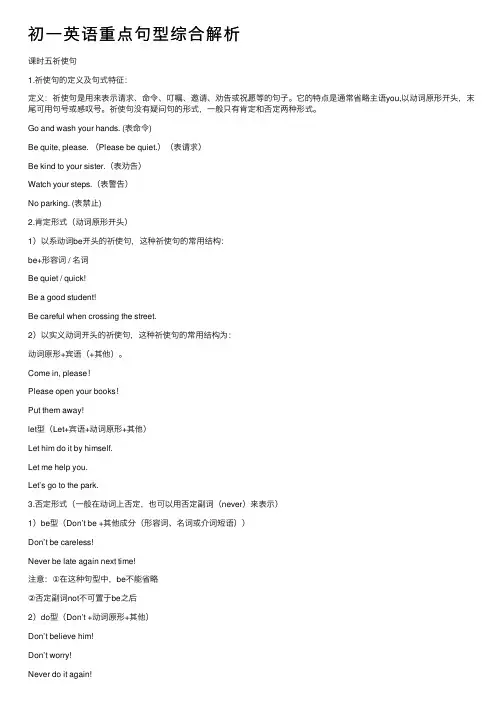
初⼀英语重点句型综合解析课时五祈使句1.祈使句的定义及句式特征:定义:祈使句是⽤来表⽰请求、命令、叮嘱、邀请、劝告或祝愿等的句⼦。
它的特点是通常省略主语you,以动词原形开头,末尾可⽤句号或感叹号。
祈使句没有疑问句的形式,⼀般只有肯定和否定两种形式。
Go and wash your hands. (表命令)Be quite, please. (Please be quiet.)(表请求)Be kind to your sister.(表劝告)Watch your steps.(表警告)No parking. (表禁⽌)2.肯定形式(动词原形开头)1)以系动词be开头的祈使句,这种祈使句的常⽤结构:be+形容词 / 名词Be quiet / quick!Be a good student!Be careful when crossing the street.2)以实义动词开头的祈使句,这种祈使句的常⽤结构为:动词原形+宾语(+其他)。
Come in, please!Please open your books!Put them away!let型(Let+宾语+动词原形+其他)Let him do it by himself.Let me help you.Let’s go to the park.3.否定形式(⼀般在动词上否定,也可以⽤否定副词(never)来表⽰)1)be型(Don’t be +其他成分(形容词、名词或介词短语))Don’t be careless!Never be late again next time!注意:①在这种句型中,be不能省略②否定副词not不可置于be之后2)do型(Don’t +动词原形+其他)Don’t believe him!Don’t worry!Never do it again!3)Let引起的祈使句有两种否定形式a. Let+宾语+not+动词原形+其他Let her not do that.Let’s not think about it. It’s only a waste of time.b. Don’t+ let+宾语+动词原形+其他Don’t let Jim do that.Don’t let us go, please.4) 在公共场合的提⽰语中,否定祈使句常⽤“No+名词 / V-ing形式”结构,表⽰“禁⽌做某事”。
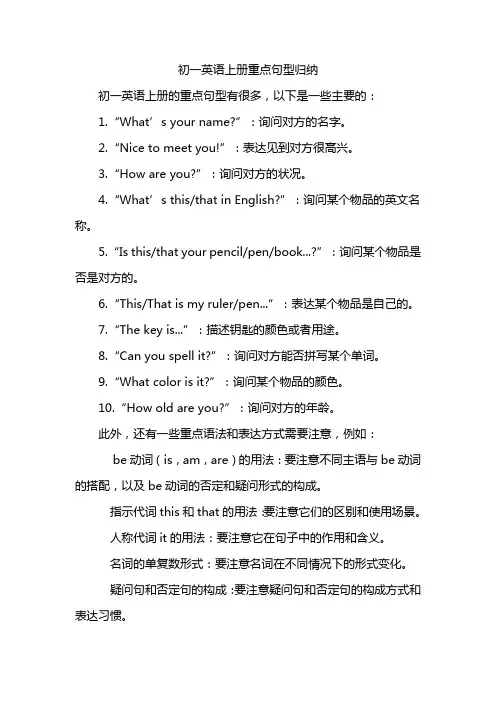
初一英语上册重点句型归纳
初一英语上册的重点句型有很多,以下是一些主要的:
1.“What’s your name?”:询问对方的名字。
2.“Nice to meet you!”:表达见到对方很高兴。
3.“How are you?”:询问对方的状况。
4.“What’s this/that in English?”:询问某个物品的英文名称。
5.“Is this/that your pencil/pen/book...?”:询问某个物品是否是对方的。
6.“This/That is my ruler/pen...”:表达某个物品是自己的。
7.“The key is...”:描述钥匙的颜色或者用途。
8.“Can you spell it?”:询问对方能否拼写某个单词。
9.“What color is it?”:询问某个物品的颜色。
10.“How old are you?”:询问对方的年龄。
此外,还有一些重点语法和表达方式需要注意,例如:
be动词(is,am,are)的用法:要注意不同主语与be动词的搭配,以及be动词的否定和疑问形式的构成。
指示代词this和that的用法:要注意它们的区别和使用场景。
人称代词it的用法:要注意它在句子中的作用和含义。
名词的单复数形式:要注意名词在不同情况下的形式变化。
疑问句和否定句的构成:要注意疑问句和否定句的构成方式和表达习惯。
以上信息仅供参考,建议查阅初一英语上册的教材或相关辅导资料,以获取更全面和准确的知识点归纳。
以下是一些可能被认为是重点句子的例子,涵盖了基础的语法结构和常用的表达方式:1. Greetings -问候:- Hello! How are you?- Hi, I'm fine. Thank you. And you?2. Introducing Yourself -自我介绍:- My name is [Your Name]. I am 13 years old.- I come from [Your City/Country].3. Talking about Hobbies -谈论爱好:- I like playing basketball. What about you?- She enjoys reading books in her free time.4. Asking and Giving Directions -问路和指路:- Excuse me, where is the nearest post office?- Go straight, and then turn left at the traffic lights.5. Describing Daily Activities -描述日常活动:- I get up at 7 o'clock every morning.- After school, I usually do my homework.6. Talking about Family -谈论家庭:- I have a brother and a sister.- My father is a doctor, and my mother is a teacher.7. Making Plans -制定计划:- Let's go to the movies on Saturday.- What are you doing this weekend?8. Ordering Food -点餐:- I would like a hamburger and a cola, please.- Can I have the menu, please?9. Expressing Likes and Dislikes -表达喜好和不喜好:- I love playing the piano.- I don't like spicy food.10. Talking about School Subjects -谈论学科:- My favorite subject is English.- Math is difficult, but I find it interesting.这些句子涉及到基础的日常用语、语法结构和常见的情景对话,是初一英语学习中的重点。
初一英语句型大全一、基本句型1. 主谓句型(Subject + Verb)* 描述某人或某物如何动作或自身怎样运动。
* 例如:They arrived.(他们到达了。
)2. 主谓宾句型(Subject + Verb + Object)* 描述某人或某物做什么事情,或某人或某物发出了动作,并且其动作涉及到另一个人或物。
* 例如:I study English.(我学习英语。
)3. 主谓双宾句型(Subject + Verb + Indirect Object + Direct Object)* 描述某人为谁(间接宾语为人)做某事,或某人或物的运动涉及到两个对象,其中一个间接对象为人,另一个为物。
* 例如:Our teacher taught us English.(我们的老师教我们英语。
)4. 主谓宾宾补句型(Subject + Verb + Object + Object Complement)* 描述某人或某物要求(使、让)某人做什么,或某人感觉某人或物怎么样。
* 例如:He asked her to go there.(他让她去那里。
)5. 主系表句型(Subject + Link Verb + Predicative)* 描述某人(某物、某事、某种概念)具有什么特征或处于什么状态。
* 例如:I am a teacher.(我是一名老师。
)二、复合句型1. 并列句(Compound Sentence)* 由两个或两个以上的简单句或复合句用并列连词(如and, or, but等)连接而成。
* 例如:She likes apples and oranges.(她喜欢苹果和橘子。
)2. 复合句(Complex Sentence)* 由一个主句和一个或多个从句组成,从句通常由连词(如that, if, when等)引导。
* 例如:If it rains, we will cancel the picnic.(如果下雨,我们将取消野餐。
1 初一至初三全程英语知识点总结及练习 初一年级(上) I. 重点短语 1. Sit down 2. on duty 3. in English 4. have a seat 5. at home 6. look like 7. look at 8. have a look 9. come on 10. at work 11. at school 12. put on 13. look after 14. get up 15. go shopping 1. help sb. do sth. 2. What about…? 3. Let’s do sth. 4. It’s time to do sth. 5. It’s time for … 6. What’s…? It is…/ It’s… 7. Where is…? It’s…. 8. How old are you? I’m…. 9. What class are you in? I’m in…. 10. Welcome to…. 11. What’s …plus…? It’s…. 12. I think… 13. Who’s this? This is…. 14. What can you see? I can see„. 15. There is (are) …. 16. What colour is it (are they)? It’s (They’re)… 17. Whose …is this? It’s…. 18. What time is it? It’s…. III. 交际用语 1. Good morning, Miss/Mr…. 2. Hello! Hi! 3. Nice to meet you. Nice to meet you, too. 4. How are you? I’m fine, thank you/thanks. And you? 5. See you. See you later. 6. Thank you! You’re welcome. 7. Goodbye! Bye! 8. What’s your name? My name is …. 9. Here you are. This way, please. 10. Who’s on duty today? 11. Let’s do. 12. Let me see.
IV. 重要语法 1. 动词be的用法; 2. 人称代词和物主代词的用法; 3. 名词的单复数和所有格的用法; 4. 冠词的基本用法; 5. There be句型的用法。 【名师讲解】 1.in/on 在表示空间位置时,in表示在某个空间的范围以内,on表示在某一个物体的表面之上。 例如:There is a bird in the tree. 树上有只鸟。There is a picture on the wall. 墙上有张图。 2. this/that/these/those (1)this常常用来指在时间、地点上更接近讲话人的人和事,these是this的复数形式。that常常用来指在时间、地点上离讲话人更远一点的人和事,those时that的复数形式。例如:You look in this box and I’ll look in that one over there.你看看这个盒子,我去看那边的那个盒子。 I want this car, not that car. 我想要这辆小汽车,不是那一辆。 Take these books to his room, please. 请把这些书拿到他房间去。 This is mine; that’s yours. 这个是我的,那个是你的。 2
These are apples; those are oranges. 这些是苹果,那些是橘子。 (2)在打电话的用语中,this常常指的是我,that常常指的是对方。例如: This is Mary speaking. Who’s that? 我是玛丽。你是谁? 3. There be/ have There be "有",其确切含意为"某处或某时存在某人或某物。"其结构是:There be + 某人或某物 + 表示地点或时间的状语。There be 后面的名词实际上是主语,be 动词的形式要和主语在数上保持一致,be动词后面的名词是单数或不可数名词时用is,名词是复数时用are。例如:(1) There is a big bottle of coke on the table. 桌上有一大瓶子可乐。 (2) There is a doll in the box. 那个盒子里有个娃娃。 (3) There are many apples on the tree. 那树上有许多苹果。 总之,There be结构强调的是一种客观存在的"有"。have表示"拥有,占有,具有",即:某人有某物(sb. have / has sth.)。主语一般是名词或代词,与主语是所属关系。例如: (4) I have two brothers and one sister.我有两个兄弟,一个姐姐。 (5) That house has four rooms.那所房子有四个房间。 4. look/ see/ watch (1)look 表示“看、瞧”,着重指认真看,强调看的动作,表示有意识地注意看,但不一定看到,以提醒对方注意。,如: Look! The children are playing computer games. 瞧!孩子们在玩电脑游戏。 Look! What’s that over there? 看!那边那个是什么? 单独使用是不及物动词,如强调看某人/物,其后接介词at,才能带宾语,如: He’s looking at me。他正在看着我。 (2)see强调“看”的结果,着重的是look这个动作的结果,意思是“看到”,see是及物动词,后面能直接跟宾语。如: What can you see in the picture? 你能在图上看到什么? Look at the blackboard. What did you see on it?看黑板!你看到了什么? (3)watch“观看,注视”,侧重于场面,表示全神贯注地观看、观察或注视某事务的活动,强调过程,常用于“看电视、看足球、看演出”等。如: Yesterday we watched a football match on TV.昨天我们从电视上看了一场足球比赛。 4. put on/ / in put on意为“穿上,戴上”。主要指“穿上”这一动作, 后面接表示服装、鞋帽的名词。 in 是介词,表示“穿着”强调状态。在句中可以做定语、标语和状语。如: It’s cold outside, put on your coat. 外面冷,穿上你的外衣。 He puts on his hat and goes out. 他戴上帽子,走了出去。 The woman in a white blouse is John’s mother.穿白色衬衣的那个妇女是John的妈妈。 5. house/ home/family house :“房子”,指居住的建筑物; Home: “家”,指一个人同家人共同经常居住的地方; Family: “家庭“,“家庭成员”。例如:Please come to my house this afternoon. 今天下午请到我家来。 He is not at home. 他不在家。My family all get up early. 我们全家都起得很早。 6. fine, nice, good, well 四者都可用作形容词表示"好"之意,但前三者既可作表语又可作定语,而后者仅用作表语。主要区别在于: (1) fine指物时表示的是质量上的"精细",形容人时表示的是"身体健康",也 可以用来指"天气晴朗"。例如:Your parents are very fine. 你父母身体很健康。 That's a fine machine.那是一台很好的机器It's a fine day for a walk today.今天是散步的好时候。 (2)nice主要侧重于人或物的外表,有"美好","漂亮"的意思,也可用于问候或赞扬别人。 例如:Lucy looks nice. 露西看上去很漂亮。These coats are very nice. 那些裙子很好看。 Nice to meet you. 见到你很高兴。It's very nice of you. 你真好。 3
(3)good形容人时指"品德好",形容物时指"质量好",是表示人或物各方面都好的普通用语。例如:Her son is a good student. 她儿子是一个好学生。 The red car is very good. 那辆红色小汽车很好。 (4)well只可用来形容人的"身体好",但不能作定语,它也能用作副词作状语,多放在所修饰的动词之后。例如:I'm very well, thanks. 我身体很好,谢谢。 My friends sing well. 我的朋友们歌唱得好。 【考点扫描】 中考考点在本单元主要集中在: 1. 动词be的用法; 2. 人称代词和物主代词的用法; 3. 名词的单复数和所有格的用法; 4. 冠词的基本用法; 5. There be句型的用法。 6. 本单元学过的词汇、短语和句型; 7. 本单元学过的日常交际用语。 考试形式可以是单项填空、完型填空、短文填空、完成句子。 【中考范例】 1. (2004年北京市中考试题) Mary, please show ________ your picture. A. my B. mine C. I D. me 【解析】答案:D。该题考查的是人称代词和物主代词的用法。本题中动词show后面跟双宾语,空白处应填入人称代词的宾格me作宾语。 2. (2004年上海市徐汇区中考试题) _________ orange on the desk is for you, Mike. A. A B.An C. / D. The 【解析】答案:D。该题考查的是冠词的基本用法。因为是特指课桌上的那个橘子,所以用定冠词the。 3. (2004年哈尔滨市中考试题) ---What _______ the number of the girls in your class? ---About twenty. A. is B. am C. are D. be 【解析】答案:A。该题考查的是动词be的用法和主谓一致。the number作主语,应该是单数第三人称,动词be变为is。 4. (2004年陕西省中考试题) There _______ a football match on TV this evening. A. will have B. is going to be C. has D. is going to have 【解析】答案:B。该题考查的是There be„句型和动词have用法区别。There be句型本身就表示“在某个地方存在某个人或物”,不能和动词have混在一起用。